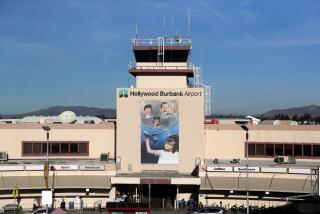AIRPORT NOISE / The Sound and the Fury
- Share via
In recent months, noise from Van Nuys and Burbank airports has been the topic of heated debate among pilots, airport officials, residential neighbors, elected officials and school representatives.
At the Van Nuys Airport, the nation’s busiest general aviation airfield, noise from helicopters, particularly sightseeing flights, has prompted a Benedict Canyon homeowner group to petition the Federal Aviation Administration to adopt restrictions for helicopters flying over “noise sensitive” neighborhoods.
Meanwhile, Burbank Airport, a commercial airfield with regularly scheduled flights, has been sued by the city of Los Angeles and the Los Angeles Unified School District for failing to study the potential noise problems created by a new, larger terminal that is to be completed by 2010. State noise measurements, however, show that noise spilling onto neighborhoods adjacent to the airport has gradually decreased over the years.
MEASURING NOISE
To measure noise, airports statewide use a standard quarterly noise-reading system that produces imaginary lines around the airport on a map, creating noise zones called “footprints.” The state measures noise through the “65 CNEL footprint,” which encloses the residential area where the average noise readings are 65 decibels or higher. Because people living within this zone are routinely bothered by aircraft noise, the state requires airports to work to reduce the noise footprint as much as possible.
Van Nuys Airport
Residential acres within the noise footprint: 48.
Residential acres in noise footprint in 1986: 23.
Houses and apartments within the noise footprint: 408.
People living within the noise footprint: 974.
Loudest aircraft operating at airport: Boeing 727, creating 83 to 90 decibels on takeoff.
Quietest aircraft operating at airport: single- and twin-engine training Pipers and Cessnas creating 53 to 60 decibels.
Average takeoffs and landings per month: 45,000.
Noise Abatement Rules:
* No departures between 11 p.m. and 7 a.m. except for military, police, fire or other emergency aircraft or aircraft that produces less than 74 decibels of noise on takeoff.
* No repetitive operations such as “touch and go” landing practice by propeller-driven planes from 10 p.m. to 7 a.m. between June 21 and Sept. 15, and 9 p.m. and 7 a.m. during the rest of the year.
* No engine testing or “run-ups” between 7 p.m. and 7 a.m.
Penalties: Civil penalties of $750 for first violation. Any person with three or more violations in a three-year period can be denied use of the airport for three years.
Number of civil penalties issued last year for violating noise abatement rules: None.
Recommended Noise Control Procedures (Voluntary):
* When plane is departing south, it should fly over adjacent Sepulveda Basin before starting turn.
* When plane is departing north, it should climb 1,800 feet before starting turn.
* Helicopters should climb 1,300 feet and use one of six routes over unpopulated areas to depart.
Burbank Airport
Residential acres within the noise footprint: 350.
Residential acres within the noise footprint in 1986: 437.
Houses and apartments within the noise footprint: 1,578.
People living within the noise footprint: 4,213.
Loudest aircraft operating at airport: Modified Boeing 727 at 100 decibels on takeoff.
Quietest air carrier operating at airport: Metroliner at 80 decibels on takeoff.
Average takeoffs and landings per month: 17,500.
Mandatory Noise Control Rules:
Between 10 p.m. and 7 a.m. pilots are prohibited from:
* Engine testing or “run-ups.”
* Repetitive training runs, training approaches or “touch and go” landing practice.
* Landing or taking off in “noisy” aircraft, which include large, older jets. A list of “noisy” aircraft is provided by the airport.
Number of citations last year for violating noise abatement rules: One for $1,000.
Sounds Like . . .
Airport noise depends on aircraft, locations of the listener and even time of day. A 7 a.m. takeoff could be perceived as being louder than one at 2 p.m. Under the decibel system, a sound measured at 30 dB is 10 times as loud as one at 20 dB. Some examples:
dB(A) Over-all level Typical noises 130 120 Uncomfortably Military jet taking off loud Rock band 110 100 Very Boeing 727 taking off loud 90 Motorcycle 80 Diesel truck 70 Moderately Passenger car 60 loud Electric typewriter 50 Quiet Conversation 40 Bird Calls 30 Just audible 20 10 Threshold of hearing 0
Source: Federal Aviation Administration, Burbank and Van Nuys airports.
More to Read
Sign up for Essential California
The most important California stories and recommendations in your inbox every morning.
You may occasionally receive promotional content from the Los Angeles Times.













